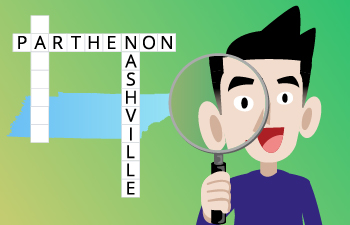Before European settlers even arrived to the land that would become Tennessee, two native American tribes had already made it their home. One of them, the Cherokees, established a small village called “Tanasi.” Once the land was being developed, settlers decided to keep the name of that small Cherokee Village. This led to the birth of the state’s name: Tennessee.
Discover more about the history and geography of the Volunteer State in this homeschool unit study supplement. This is part of Time4Learning’s full series of United States unit study supplements. You can also download our list of PreK-12 interactive activities that align with your study of interesting facts about Tennessee.
Tennessee Fast Facts
| Became a State |
June 1, 1796 |
|---|---|
| Order it Joined the Union |
16th state |
| State Capital |
Nashville |
| State Abbreviation |
TN |
| Border States | |
| State Flag |  |
| State Songs | |
| State Flower |
Irises |
| State Nicknames |
|
| Notable Tennesseans |
|
Historical Facts About Tennessee
Tennessee was first explored by Europeans in 1540, although it had been inhabited as long as 20,000 years ago. When European settlers first arrived, there were two Native American tribes already established: the Cherokees and the Chickasaw.
The tribes and the settlers were at peace in the early 1700s, but the tribes became angry as the settlers claimed more land. After the French and Indian war, the tribes were removed and Britain gained control of the land in 1763. At this point, Tennessee was just a part of North Carolina, even after the American Revolution ended.
In 1784, Eastern Tennessee tried to become its own state, originally requesting to be called “Franklin.” This lasted until 1788, and all of Tennessee became a U.S. territory in 1789 during George Washington‘s first term as president. Finally, on June 1, 1796. U.S. Congress made Tennessee into a state.
When the Civil War broke out in 1861, Tennessee was originally divided between the Union and Confederacy, but it eventually sided with the Confederacy. Many major battles fought during the Civil War occured in Tennessee, and the Union had lots of control over Tennessee. Later, in 1920, Tennessee became known for its country music due to a popular radio show that started in the state called “The Grand Ole Opry.”
Your kids will love learning about Tennessee’s history using the timeline below:
880
Inhabited by the Chickasaw and the Cherokee. The Chickasaw were known to live in the west and the Cherokee were in the east.
1540
First explored by Hernando de Soto, who left to seek gold.
1740
Cherokee Village capital was named “Tanasi,” which later developed into the name of the state.
1779
The first city was founded, called Nashborough. This city later developed to become Nashville.
1783
European settlers arrived, the British claimed the land, and removed the Native American Tribes.
1784
Jonesborough was named the first capital of Tennessee, and eastern Tennessee tries to become a state, named “Franklin”.
1785
Capital moved from being in Jonesborough to being in Greeneville.
1789
All of Tennessee became a U.S. Territory.
1796
Tennessee became the 16th state to enter the union, and the capital was moved to Knoxville.
1807
Capital was moved to Kingston for just one day, to satisfy an agreement made with Native Americans. It was moved back to Knoxville the next day.
1812
The state nickname of “The Volunteer State” was received because of the many volunteer soldiers who fought in the War of 1812 that were from Tennessee. The capital was moved to Nashville.
1817
Knoxville became the capital again, for the third time.
1818
Murfreesboro became the capital, which was the sixth city it was moved to.
1826
Nashville became the permanent capital, and has not moved since.
1861
Tennessee was the last state to secede from the Union and join the Confederacy.
1866
Rejoins the Union after the Civil War ends.
1920
Became known for its country music because of a radio show called “The Grand Ole Opry”.
1925
The first official state song was released, called “My Homeland, Tennessee”.
1927
First miniature golf course was started in Chattanooga. It was created to help the hotel gain more bookings.
1970
State became politically divided; the office of the Governor has never been completely Democratic or Republican since.
2012
Tennessee’s 10th state song, “Tennessee,” is created.
Bring history and geography to life with Time4Learning’s interactive online social studies curriculum for grades 2-12.
Geographical Facts About Tennessee
Can your homeschooler locate Tennessee on this printable U.S. map? Tennessee is often referred to as the state of rivers because of how many large and important rivers there are. It is also home of the Great Smoky Mountains National Park, the most visited national park in the U.S. These are just some of the interesting facts about the Volunteer State’s geography that your homeschooler will find interesting.
To enhance your unit study supplement, explore a map of the state then download our printable Tennessee map below and mark it up with your child. Here are some facts you and your homeschooler may want to note about Tennessee’s geography and its unique features.
- The highest point in Tennessee is Clingmans Dome, which is 6,643 feet tall. It is located on the border shared with North Carolina, about 50 miles southeast of Knoxville. This dome is a part of the Great Smoky Mountains National Park!
- Over the years, 6 different cities were named the capital of Tennessee: Jonesborough, located in the northeastern tip of Tennessee; Greeneville, located just 20 miles southwest of Jonesborough; Knoxville, which is 70 miles west of Greeneville; Kingston is 30 miles west of Knoxville; Murfreesboro is 100 miles west of Kingston; and finally, Nashville is 30 miles north of Murfreesboro. Can you locate all these cities on the map?
- Murfreesboro, one of the previous state capital, is located right in the geographical middle of Tennessee.
- The flag of Tennessee has three stars on it, and the stars symbolize the three geographical regions in this state: the Great Smoky Mountains, the highlands, and the lowlands. The mountains are in eastern Tennessee, the highlands in central Tennessee, and lowlands in western Tennessee.
- Tennessee’s western border, shared with Arkansas, is very squigle-y. This is because the border was carved out by the Mississippi river!
- The Norris Dam was the first hydroelectric dam ever built, and is located just north of Knoxville. The town was created specifically to house construction workers that built the dam.
- Lookout Mountain, which is 1,850 feet high, provides views of seven out of eight bordering states on a clear day. It is located in Chattanooga, resting right on the Tennessee-Georgia borderline. It is about 100 miles southeast of Nashville.
Tennessee State Map
Download our FREE Tennessee state map printable. Use it as a coloring page or use it to plot the state’s geographical features.
Activities for Children in Tennessee
Whether you are a homeschooler in Tennessee, or just a family who is planning a trip to the Volunteer State in the near future, you should be aware of some of the educational destinations in the state. Enhance your Tennessee state facts study with these field trip ideas.
- Discovery Park of America (Union City) – Take a trip to this 100,000 square foot museum with a ton of different exhibits! Some are permanent and others are on a rotating schedule, so make sure to explore the website prior to visiting. This experience focuses around natural science, history, technology, and art.
- The Hermitage (Nashville) – Andrew Jackson was one of the most famous people to come out of Tennessee. At The Hermitage, you can take a tour of President Jackson’s mansion, led by an experienced tour guide. There are occasionally homeschool days, so keep an eye on the events schedule!
- Cumberland Caverns (McMinnville) – This caving system is one of the most explored in America! There are daytime and overnight trips, as well as a group discount option. Make sure your homeschoolers are ready to hike – the minimum distance is about a mile and half long.
- Chattanooga Hop Trolley Tour (Chattanooga) – Historic Chattanooga has so much to see that it can feel overwhelming! The Chattanooga Hop Trolley Tour allows you to take the whole day exploring what this city has to offer. With 8 different stops, a ticket allows you to hop and off the trolley as it takes you to different attractions.
- East Tennessee Historical Society (Knoxville) – Eastern Tennessee has lots of history behind it, including being the birthplace of the Tennessee Valley Authority. See exhibits that illustrate the content in this Tennessee unit study supplement, such as the story of Tennessee’s nickname of the Volunteer State.
Tennessee Freebies and Deals for Homeschoolers
- World’s Fair Park (Knoxville) – Did you know that the 1982 World’s Fair took place in Knoxville? To remember this event, the land used for the fair was turned into a free park. Take your homeschoolers on a trip up in the Sunsphere to get a breathtaking view of Knoxville and the surrounding Tennessee area!
- Davy Crockett Birthplace State Park (Limestone) – Famous frontiersman Davy Crockett was born in Tennessee! This state park has a replica of the 18th century cabin that Crockett lived in. There is also a beautiful monument and lots of different natural areas to explore in the park.
- Lichterman Nature Center (Memphis) – This nature and environmental education center is perfect for homeschoolers who live in the city! There are so many different plants and animals to see; the park is over 65 acres. Admission is normally under $10, but every Tuesday from 1-3pm, the nature center is free.
- Dunbar Cave State Park (Clarksville) – Earlier in this unit study supplement, it was mentioned that Tennessee land was inhabited over 20,000 years ago. This state park offers proof, with historic cave drawings and useful resources. Admission is free, and offers plenty of supplemental information to learn geography.
- Tennessee State Museum (Nashville) – There are so many different exhibits to see in The Volunteer State’s capitol! Take a guided tour through the State Capitol building, walk through the Military Museum, or enjoy learning about Tennessee’s interesting history at the state museum. All three museums are free and located in the heart of downtown Nashville!
Tennessee Learning Games for Children
Make sure to check out these available resources to assess your child’s knowledge about Tennessee and learn even more about the Bluegrass State.












